克鲁格曼 国际金融课件 第二章
- 格式:ppt
- 大小:453.00 KB
- 文档页数:25
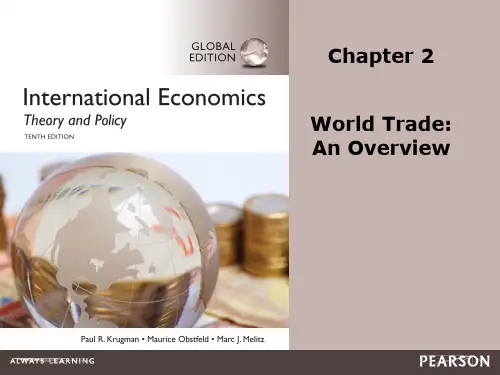
![国际经济学克鲁格曼版[]PPT课件](https://uimg.taocdn.com/90382b676c175f0e7dd1372e.webp)
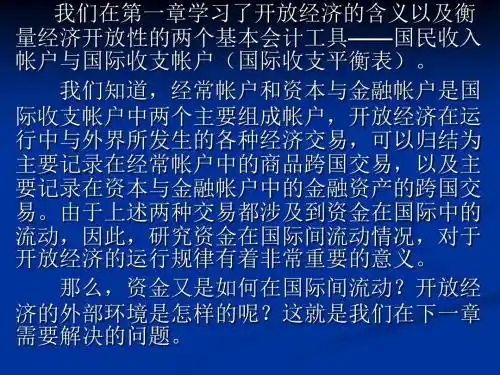
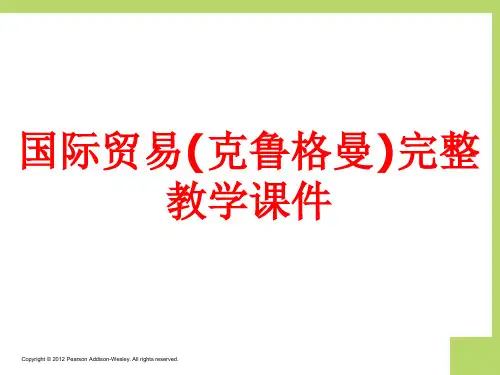


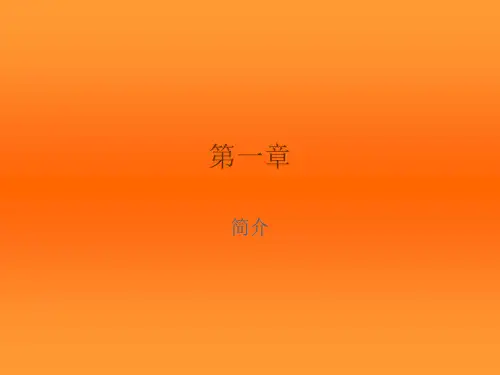
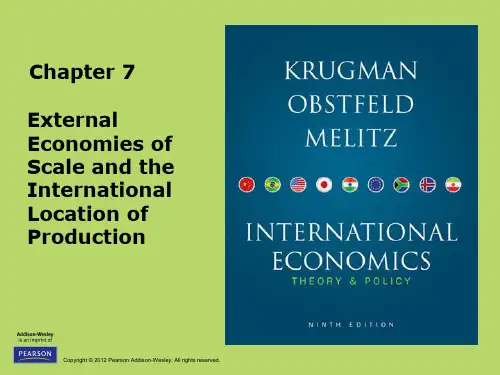
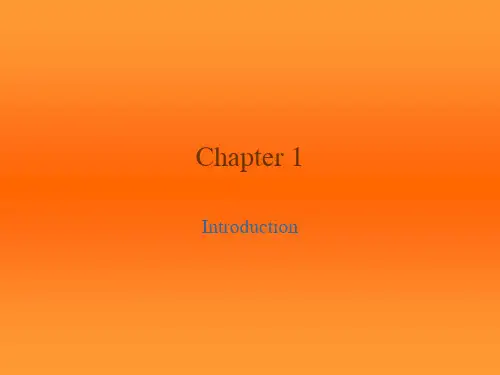
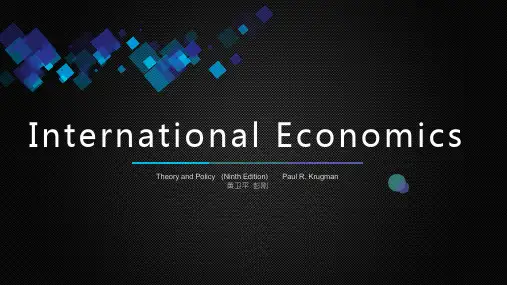
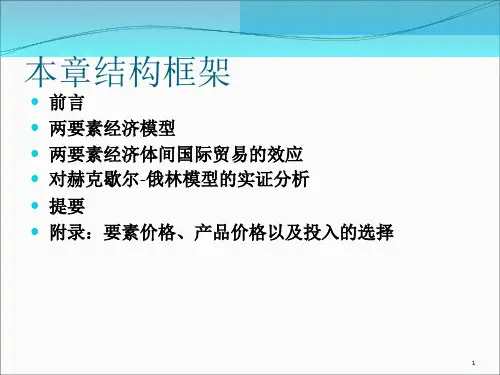
保罗克鲁格曼国际经济学英⽂课件1-7章Preface§1. Some distinctive features of International Economics: Theory and Policy.This book emphasizes several of the newer topics that previous authors failed to treat in a systematic way:·Asset market approach to exchange rate determination.·Increasing returns and market structure.·Politics and theory of trade policy.·International macroeconomic policy coordination·The word capital market and developing countries.·International factor movements.§2. Learning features:·Case studies·Special boxes·Captioned diagrams·Summary and key terms·Problems·Further reading§3.Reference books:·[美]保罗?克鲁格曼,茅瑞斯?奥伯斯法尔德,《国际经济学》,第6版,中译本,中国⼈民⼤学出版社,2007.·李坤望主编,《国际经济学》,第⼆版,⾼等教育出版社,2005.·Dominick Salvatore, International Economics, Prentice Hall International,第9版,清华⼤学出版社,英⽂版,2008. Chapter 1Introduction·Nations are more closely linked through trade in goods and services, through flows of money, and through investment than ever before.§1. What is international economics about?Seven themes recur throughout the study of international economics:·The gains from trade(National welfare and income distribution)·The pattern of trade·Protectionism·The balance of payments·Exchange rate determination·International capital market§2. International economics: trade and money·Part I (chapters 2 through 7) :international trade theory·Part II (chapters 8 through 11) : international trade policy ·Part III (chapters 12 through 17) : international monetary theory ·Part IV (chapters 18 through 22) : international monetary policyChapter 2 World Trade: An Overview§1 Who Trades with Whom?1. Size Matters: The Gravity ModelThe size of an economy is directly related to the volume of imports and exports.Larger economies produce more goods and services, so they have more to sell in the export market. Larger economies generate more income from the goods and services sold, so people are able to buy more imports.3 of the top 10 trading partners with the US in 2003 were also the 3 largest European economies: Germany, UK and France. These countries have the largest gross domestic product (GDP) in Europe.Cultural affinity: if two countries have cultural ties, it is likely that they also have strong economic ties.Geography: ocean harbors and a lack of mountain barriers make transportation and tradeeasier.2. Distance Matters: The Gravity ModelDistance between markets influences transportation costs and therefore the cost of imports and exports. Distance may also influence personal contact and communication, which may influence trade.Estimates of the effect of distance from the gravity model predict that a 1% increase in the distance between countries isassociated with a decrease in the volume of trade of 0.7% to 1%.Borders: crossing borders involves formalities that take time and perhaps monetary costs like tariffs. These implicit and explicit costs reduce trade. The existence of borders may also indicate the existence of different languages or different currencies, either of which may impede trade more.3.The gravity modelThe gravity model is:a b c ij i j ijT A Y Y D =?? where a, b, and c are allowed to differ from 1.§2. The Changing Composition of Trade1. Has the World Become “Smaller ”?There were two waves of globalization.1840–1914: economies relied on steam power, railroads, telegraph, telephones. Globalization was interrupted and reversed by wars and depression.1945–present: economies rely on telephones, airplanes, computers, internet, fiber optics,…2. Changing Composition of TradeToday, most of the volume of trade is in manufactured products such as automobiles, computers, clothing and machinery. Services such as shipping, insurance, legal fees and spending by tourists account for 20% of the volume of trade.Mineral products (e.g., petroleum, coal, copper) and agricultural products are a relatively small part of trade.Multinational Corporations and OutsourcingBefore 1945, multinational corporations played a small role world trade.But today about one third of all US exports and 42% of all US imports are sales from one division of a multinational corporation to another.Chapter 3Labor Productivity and Comparative Advantage:The Ricardian Model*Countries engage in international trade for two basic reasons:·Comparative advantage: countries are different in technology (chapter 3) or resource (chapter 4).·Economics of scale (chapter 6).*All motives are at work in the real world but only one motive is present in each trade model.§1. The concept of comparative advantage1. Opportunity cost : The opportunity cost of roses in terms of computers is the number of computers that could have been produced with the resources used to produce a given number of roses.Table 3-1 Hypothetical Changes in Production Million Roses Thousand Computers United States-10 +100 South America+10 -30 Total 0 +702. Comparative advantage : A country has a comparative advantage in producing a good if the opportunity cost of producing that good in terms of other goods is lower in that country than it is in other countries.·Denoted by opportunity cost.·A relative concept : relative labor productivity or relative abundance.3. The pattern of trade: Trade between two countries can benefit both countries if each country exports the goods in which it has a comparative advantage.§2. A one-factor economy1.production possibilities: LC C LW W a Q a Q L +≤Figure 3-1 Home’s Production Possibility Frontier2. Relative price and supply·Labor will move to the sector which pays higher wage.·If C W LC LW P P a a >(C LC W LW P a P a >, wage in the cheese sector is higher ), the economy will specialize in the production of cheese.·In a closed economy, C W LC LW P P a a =.·If each country has absolute advantage in one good respectively, will there exist comparative advantage?§3. Trade in a one-factor world·Model : 2×1×2·Assume: **LC LW LC LW a a a a <Home has a comparative advantage in cheese.Home ’s relative productivity in cheese is higher.Home ’s pretrade relative price of cheese is lower than foreign.·The condition under which home has the comparative advantage involves all four unit labor requirement, not just two.1. Determining the relative price after trade·Relative price is more important than absolute price, when people make decisions on production and consumption.·General equilibrium analysis: RS equals RD . (World general equilibrium)·RS : a “step ” with flat sections linked by a vertical section. **(/)(/)LC LW L a L aFigure 3-3 World Relative Supply and Demand·RD : subsititution effects·Relative price after trade: between the two countries ’ pretrade price.(How will the size of the trading countries affect the relative price after trade? Which country ’s living condition improves more? Is it possible that a country produce both goods?)2. The gains from tradeThe mutual gain can be demonstrated in two alternative ways.·To think of trade as an indirect method of production :(1/)()1/LC C W LW a P P a > or C W LC LW P P a a >·To examine how trade affects each country ’s possibilities of consumption.Figure 3-4 Trade Expands Consumption Possibilities(How will the terms of trade change in the long-term? Are there income distribution effects within countries? )3. A numerical example:·Two crucial points :When two countries specialize in producing the goods in which they have a comparative advantage, both countries gain from trade.Comparative advantage must not be confused with absolute advantage; it is comparative, not absolute, advantage that determines who will and should produce a good.Table 3-2 Unit Labor Requirements Cheese WineHome 1LC a = hour per pound 2LW a = hours per gallonForeign*6LC a = hours per pound *3LW a = hours per gallon absolute advantage; relative price; specialization; the gains from trade.4. Relative wages·It is precisely because the relative wage is between the relative productivities that each country ends up with a cost advantage in one good.***LC LC LW LW a a w w a a >> **LC LC wa w a <;**LW LW wa w a >·Relative wages depend on relative productivity and relative demand on goods.Special box: Do wages reflect productivity?。